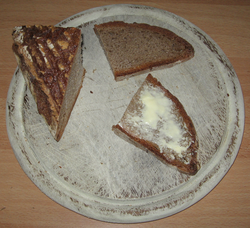 | |
| Type | Sandwich |
|---|---|
| Place of origin | Germany |
| Main ingredients | Bread, butter |
In German cuisine, Butterbrot (literally: butter bread = bread with butter) is a slice of bread topped with butter. Also known as boterham in Dutch speaking countries, it is still considered Butterbrot or boterham even if additional toppings, such as cheese, spreads, or lunch meats, are added, as long as it begins with a slice of bread with butter.
The words in formal and colloquial German and the different dialects for butterbrot (different from belegtes Brot - with cheese, sausages etc.), simply Brot ("bread"), Butterstulle, Stulle, Schnitte (all three Low German/Berlinerisch dialect), Botteramm (Colognian dialect, cf. Dutch boterham), Bütterken (Lower Rhine dialect) to Bemme (Upper Saxon German) or Knifte (Ruhrdeutsch). Although it is increasingly replaced by other foods, it remains a common staple food in Germany. Since 1999, the last Friday in the month of September was made the Day of German Butterbrot by the Marketing Organization of German Agricultural Industries.[1]
The Russian language adopted the term buterbrod (бутерброд) from New High German (Butterbrot),[2] perhaps as early as the 18th century during the reign of Peter the Great. In modern Russian the term has a more general meaning, whatever the ingredient on top of the slice of bread is. From Russian, the term buterbrod was adopted into Azerbaijani, Belarusian, Georgian, Kazakh, Ukrainian, and Lithuanian.
- ^ "Tag des Deutschen Butterbrotes". berlinonline.de. Archived from the original on 1 October 2011. Retrieved 18 October 2010.
- ^ Что такое БУТЕРБРОД - Этимологический русскоязычный словарь Фасмера - Словари - Словопедия